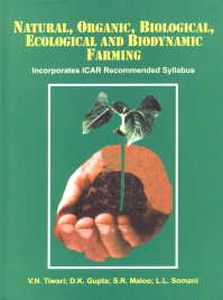
Contents: Preface. About the book. About the editors. 1. Organic farming-retrospect and prospect. 2. Organics and inorganics in food grain production--an overview. 3. Biodynamics of organic farming. 4. Biological weed control. 5. Blue-green algae and sustainable agriculture. 6. Composting--a potential tool for organic recycling. 7. Composting of organic wastes. 8. Green manuring. 9. Management of organo-wastes through microbes. 10. Modern technique of Vermicomposting. 11. Nurturing soil and crop health by organic inputs. 12. Production and quality control in microbial inoculants. 13. Recycling of crop residues and role of earthworm in soil management. 14. Role of bioagents and biopesticides in organic farming. 15. Role of biofertilizers in sustainable agriculture. 16. Vermiwash. 17. Wastes management through vermi-bio technology--a sustainable approach in agriculture. 18. Azolla--a potential biofertilizers and green manure. 19. Bioremediation and biomass utilization. 20. Cyanobacteria as ameliorating agent of salt affected soils. 21. Integrated approaches in weed management. 22. Integrated nutrient management. 23. Organic faming--problems and prospects. 24. Certification and legislation of organic products. 25. Constraints, limitations and issues of organic farming. 26. Production, protection and quality of organic produce. 27. Scientific feasibility and validity of organic farming. 28. SREP Approach for promoting organic farming. 29. Strategies for promotion of organic farming. 30. Biological control of plant parasitic nematodes. 31. Subject index.
"Organic farming methods are widely used in all three groups of countries (developed, developing and underdeveloped) in the world. In developing and underdeveloped countries organic farming is mostly preferred due to lack of chemicals and economics while, in developed countries it is accepted for avoiding demerits of chemical fertilizers and pesticides and protecting environment. Organic farming is crop rotations, use of biofertilizers and animal manures, and biological pest control. However, indiscriminate and increasing use of chemical fertilizers and pesticides has led to serious problems in agroecosystem such as pest resistance, secondary pest outbreak, pest resurgence, destruction to ecocycles and endemic soil fauna and dying of soil etc. The present book will be helpful for understanding characteristics of biofertilizers, Vermiculture and biocontrol agents, their production techniques and applications and thus, solve the above problems. This book is a need of modern agriculture.
Organic farming is thus considered as a movement directed towards the philosophy of "Back to Nature". It aims at low input farming thus reducing dependence on inorganic fertilizers, plant protection chemical and weedicides.
The book contains 30 chapters each contributed by authorities in their field of specialization highlighting their vast experience relevant to natural, organic, biological, ecological, and bydynamic aspects of no-chemical farming.
Considering the vast scope and huge export potential of organic foods from India, such types of information on status, strategy and scope in the form of a book was a long felt need. Since, this is the beginning of popularizing such technologies, the outcome of this book will serve the purpose of the target audience.
This book should be of interest and use to students, teachers, researchers of agricultural colleges and universities, administrators and extension officers, consultants, rural development and training centres and other agencies who are involved in production and promotion of organic food.
The book will serve as a good reference book on Organic Food Production." (jacket)